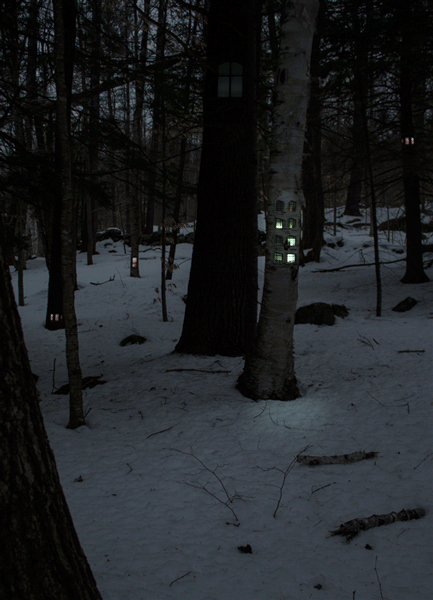The animated .gif, or simply GIF, has come a long way from its flashy pixelated beginnings of the early internet. Now used to illustrate concepts, used to register any and every manner of sentiment, lifted from every second of video as soon it hits the internet, it has proliferated, its use commonplace, normalized. Recently, a variation dubbed the cinemagraph has tentatively appeared. The movement in the image is usually very isolated and very small, leaving the remainder of the image still while the subject flutters or flickers or flows in part of it. The movement, moreover, is smoothly looped in a way that the movement seems seamless and continuous. Most of easily found cinemagraphs on the internet are the work of several photographers who developed the format and coined the subsequent term, but others are out there too.
 One such is artist David Barreto, who recently created a series of photomanipulations entitled Woodhouses. Parts of houses— windows, doors— have been grafted into the bases and trunks of trees as if they belong there. What should look so very artificial instead looks natural, integrated, organic. The trees themselves are unremarkable, one of many in a wood, standing often in the half-light of predawn or dusk. At first glance, that is all there is to it. But then the windows’ fluorescent lights flicker, dim, and flicker again, casting cold rectangles out onto the still snow.
One such is artist David Barreto, who recently created a series of photomanipulations entitled Woodhouses. Parts of houses— windows, doors— have been grafted into the bases and trunks of trees as if they belong there. What should look so very artificial instead looks natural, integrated, organic. The trees themselves are unremarkable, one of many in a wood, standing often in the half-light of predawn or dusk. At first glance, that is all there is to it. But then the windows’ fluorescent lights flicker, dim, and flicker again, casting cold rectangles out onto the still snow.
There is something about the scene that is very much reminiscent of the streetlight at night and the flashing neon sign of the corner shop, the 3am car alarm and the sudden quiet after it is shut off. A man’s muffled curse and the distant sound of a door slamming shut, and then the silence resumes, a thick blanketing silence that the darkness corroborates. The harsh light, greenish, or orangish, perhaps, cuts into it oddslot, revealing, intrusive, but nonetheless silent, wordless. And that is what Woodhouses embodies, it seems. The nature of the medium demands silence; it is an image, not a video. We are intruders looking into lit windows at night, and the abrupt light is an intruder upon the darkening winter landscape outside.
The isolated animation is crucial to the effect. Because the environment is static, its details remain important. They will not pass out of frame as they might in video. And yet some part of it slips the moment, the singular moment in which an ordinary photograph might be captured, and it moves. It catches us by surprise. We cannot be too complacent, too unobservant, because something happens. Time cannot travel too far, however, because then the motion circles back on itself, and we are again suspended in the moment, preserved.


Leave a Reply
Be the First to Comment!